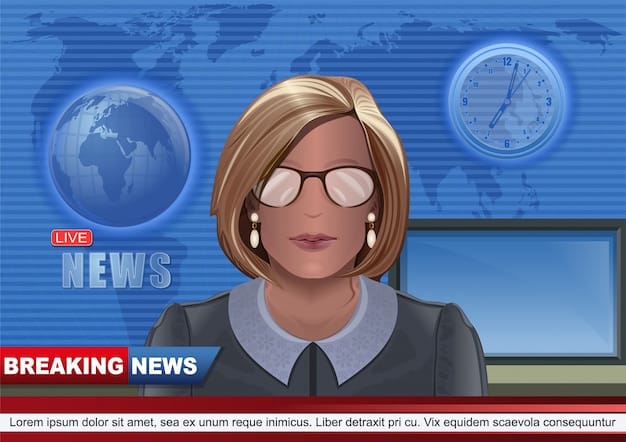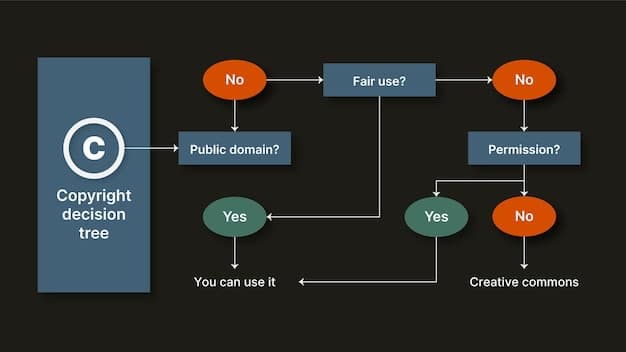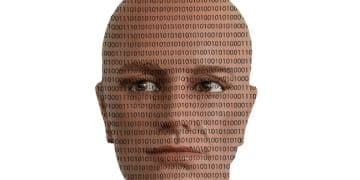Ethical Deepfakes: Social Commentary in 2025 and Its Implications

What are the Ethical Implications of Using Deepfake Technology in Social Commentary? A 2025 Perspective reveals the potential for both good and harm, highlighting concerns about disinformation and authenticity while acknowledging the creative possibilities for satire and awareness campaigns.
Navigating the complex landscape of deepfake technology in social commentary requires a careful examination of its ethical ramifications. In 2025, the proliferation of sophisticated deepfakes presents both opportunities and challenges for how we engage with information and express opinions. Let’s delve into What are the Ethical Implications of Using Deepfake Technology in Social Commentary? A 2025 Perspective, exploring the moral considerations that demand our attention.
Understanding Deepfake Technology
Deepfake technology has rapidly evolved, transforming from a novelty to a potent tool with diverse applications. Initially a niche area, it now pervades various sectors, including entertainment, politics, and social media. To comprehend its ethical implications, a foundational understanding of how deepfakes are created and utilized is essential.
The Mechanics of Deepfake Creation
Deepfakes are primarily created using artificial intelligence (AI), particularly deep learning techniques. Algorithms analyze and learn from vast datasets of images and videos to create convincing forgeries. This process typically involves:
- Data Acquisition: Gathering extensive data of the target individual, including images and videos from various angles and expressions.
- Model Training: Feeding the data into a neural network to learn the subject’s facial features, voice patterns, and mannerisms.
- Synthesis: Using the trained model to map the subject’s characteristics onto another person’s face or voice, creating a composite video or audio clip.
Applications of Deepfake Technology
The diverse applications of deepfake technology extend beyond mere entertainment. While Hollywood can use it to de-age actors or create realistic CGI, its potential is far-reaching:
- Entertainment: Creating special effects in movies, reviving deceased actors, and generating personalized content.
- Education: Simulating historical figures for immersive learning experiences and creating realistic training scenarios.
- Satire and Comedy: Producing humorous content through parody and impersonation, potentially offering insightful social commentary.
However, deepfake technology’s accessibility and sophistication have also opened the door to malicious uses. The ability to create convincing forgeries has raised significant ethical concerns, especially in the realm of social commentary.

Ethical Concerns in Social Commentary
When deepfake technology intersects with social commentary, a complex web of ethical considerations emerges. While the technology offers new avenues for creative expression and critique, it also poses threats to truth, trust, and individual reputations.
Disinformation and Misleading Narratives
One of the primary concerns is the potential for deepfakes to spread disinformation. By creating fabricated videos of public figures making controversial statements or engaging in questionable behavior, malicious actors can manipulate public opinion and incite social unrest.
Erosion of Trust in Media
The proliferation of deepfakes erodes trust in traditional media sources. When the public becomes uncertain about the authenticity of what they see and hear, it creates an environment ripe for conspiracy theories and skepticism. This can lead to a fragmented society where shared understanding becomes increasingly difficult.
Impact on Individual Reputations
Deepfakes can severely damage an individual’s reputation by portraying them in a false and damaging light. Even if the deepfake is exposed as a forgery, the initial impact can be lasting, especially in the age of rapid information dissemination.
The Need for Transparency and Disclosure
To mitigate these ethical concerns, transparency and disclosure are crucial. When deepfakes are used for social commentary, it is essential to clearly label them as such. This allows viewers to approach the content with a critical mindset and prevents unintentional deception.
Deepfake technology offers unprecedented capabilities for creative expression, yet its misuse can have severe consequences for individuals, institutions, and society as a whole. Addressing these ethical concerns requires a multi-faceted approach involving technological solutions, legal frameworks, and public awareness campaigns.
The Double-Edged Sword: Benefits and Risks
Deepfake technology, when applied to social commentary, presents a paradoxical scenario of both potential benefits and significant risks. Recognizing both sides of this equation is crucial for navigating the ethical terrain.
Potential Benefits of Deepfakes
Despite the inherent risks, deepfakes can serve as powerful tools for positive social impact:
- Raising Awareness: Using deepfakes to highlight pressing social issues, such as climate change, political corruption, or human rights abuses.
- Promoting Critical Thinking: Encouraging viewers to question the authenticity of media and cultivate healthy skepticism.
- Satirical Expression: Creating humorous and exaggerated content to critique societal norms and power structures.
Risks and Drawbacks of Deepfakes
The risks associated with deepfakes in social commentary include:
- Malicious Use: Spreading false information and propaganda to manipulate public opinion.
- Reputation Damage: Creating fabricated videos to defame individuals or organizations.
- Manipulation: Altering the context and meaning of events to deceive viewers.
Balancing the Equation
The benefits and risks of deepfakes underscore the need for a balanced approach. While acknowledging the technology’s potential for good, it’s essential to implement safeguards that prevent its misuse. This involves educating the public about deepfakes, developing detection tools, and establishing ethical guidelines for their use.
Deepfakes can be used to raise awareness and promote social change. However, the potential for misuse and manipulation remains a significant challenge. Transparency, ethics, and responsible use are key to maximizing the benefits of this technology while minimizing its negative impacts.
Legal Frameworks and Regulations
The rapid advancement of deepfake technology has outpaced existing legal frameworks, posing challenges for regulators worldwide. Establishing clear legal boundaries is essential to mitigate the risks associated with its misuse in social commentary.
Existing Laws and Their Applicability
Several existing laws can be applied to address the misuse of deepfakes, including:
- Defamation Laws: Holding individuals accountable for creating and disseminating deepfakes that harm someone’s reputation.
- Copyright Laws: Protecting intellectual property rights by preventing the unauthorized use of copyrighted material in deepfakes.
- Election Laws: Prohibiting the use of deepfakes to spread false information and influence election outcomes.
The Need for New Legislation
While existing laws provide some recourse, they may not be sufficient to address the unique challenges posed by deepfakes. Some jurisdictions are considering new legislation that specifically targets deepfake technology:
- Mandatory Disclaimers: Requiring deepfakes to be clearly labeled as such to inform viewers of their artificial nature.
- Criminal Penalties: Imposing fines or imprisonment for creating and disseminating malicious deepfakes.
- Civil Remedies: Allowing individuals harmed by deepfakes to sue for damages.
Legal frameworks and regulations play a crucial role in holding individuals accountable for misusing deepfake technology. As deepfakes become more sophisticated, laws must adapt to ensure that those who create them understand what is legally allowed and the ramifications of not adhering to the established practices.
Detection and Mitigation Strategies
As deepfakes become more sophisticated, the need for effective detection and mitigation strategies increases. Technological solutions and public awareness campaigns are essential to combat the spread of deepfake disinformation.
Technological Solutions for Deepfake Detection
Researchers and developers are constantly working on technologies to detect deepfakes:
- AI-Powered Detection Tools: Algorithms that analyze videos and audio clips for inconsistencies and anomalies indicative of deepfake manipulation.
- Blockchain Technology: Using blockchain to verify the authenticity of media by creating an immutable record of its creation and editing history.
- Reverse Image Search: Comparing a deepfake image or video to known originals to identify discrepancies.
Public Education and Awareness Campaigns
Technological solutions alone are not enough to combat deepfakes. Public awareness is key. Educating the public about deepfakes empowers individuals to question the authenticity of media and recognize the signs of manipulation. Informing the public about the technology alongside the tools that can detect the forgeries will create a population that is more equipped to handle deepfakes, regardless of their intended use.

The Future of Social Commentary and Deepfakes
Looking ahead to 2025, the relationship between social commentary and deepfake technology promises to be complex and evolving. Several trends and developments will shape this landscape.
Advancements in Deepfake Technology
Deepfake technology is expected to become even more sophisticated, making it harder to detect. This will require technological advancements in detection methods, and more critical thinking methods for public consumption.
- Enhanced Realism: Deepfakes will become virtually indistinguishable from real videos and audio clips.
- Automated Creation: AI-powered tools will automate the process of creating deepfakes, making it accessible to a wider audience.
- Personalized Deepfakes: Deepfakes will be tailored to specific individuals, making them even more persuasive and difficult to detect.
The Evolving Role of Social Media Platforms
Social media platforms will play a critical role in combating the spread of deepfakes:
- Content Moderation: Platforms will invest in AI-powered tools to detect and remove deepfakes from their sites.
- Fact-Checking Partnerships: Platforms will partner with independent fact-checkers to verify the authenticity of media.
- User Education: Platforms will provide users with resources and tools to identify and report deepfakes.
The future of social commentary in the age of deepfakes will depend on our collective ability to embrace responsible innovation and cultivate a culture of critical thinking, transparency, and accountability. Society will have to become more responsible as a whole, embracing the capabilities of the technology in a way that is mindful of the present and the future.
Key Point
Brief Description
⚠️ Disinformation
Malicious deepfakes can spread false narratives, misleading the public and inciting social unrest.
🎭 Satire
Deepfakes offer satirical opportunities to critique societal norms and challenge power structures humorously.
🛡️ Mitigation
Technological solutions and public awareness are crucial in detecting and combating deepfakes.
⚖️ Legislation
Adaptable legal frameworks are essential to regulate deepfake use and protect against potential misuse.
FAQ About Deepfake Ethics
▼
A deepfake is a manipulated video or audio clip where someone’s likeness or voice has been replaced with someone else’s, making it seem like they said or did something they didn’t.
▼
They’re created using artificial intelligence (AI), specifically deep learning algorithms, which analyze and learn from vast amounts of data to convincingly mimic a person’s appearance or voice.
▼
Deepfakes can spread disinformation, damage reputations, manipulate public opinion, and erode trust in media by creating convincing, yet false, content.
▼
Yes, deepfakes can raise awareness about social issues, promote critical thinking, and be used in satire and comedy, as long as they are clearly labeled as such.
▼
Researchers are developing AI-powered detection tools, and some jurisdictions are creating laws that penalize those who create and spread malicious deepfakes.
Conclusion
In 2025, as we continue to grapple with deepfake technology in social commentary, it’s essential to balance innovation with ethical responsibility. Ensuring transparency, promoting media literacy, and fostering critical thinking are key to navigating this complex landscape and mitigating the potential harms of deepfakes while harnessing their creative potential.





